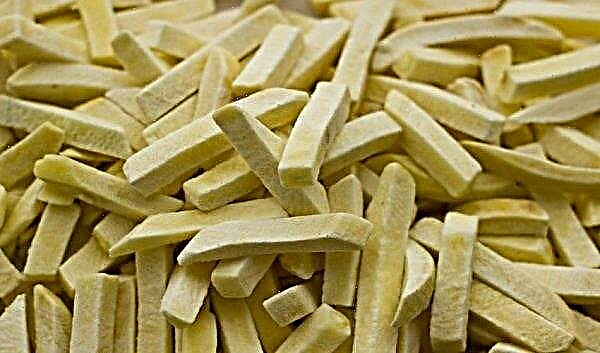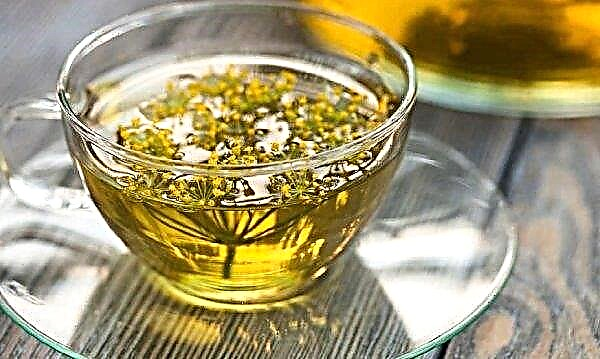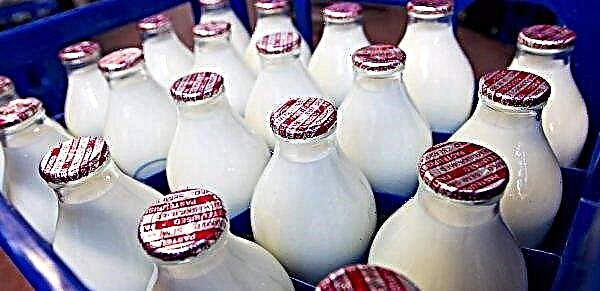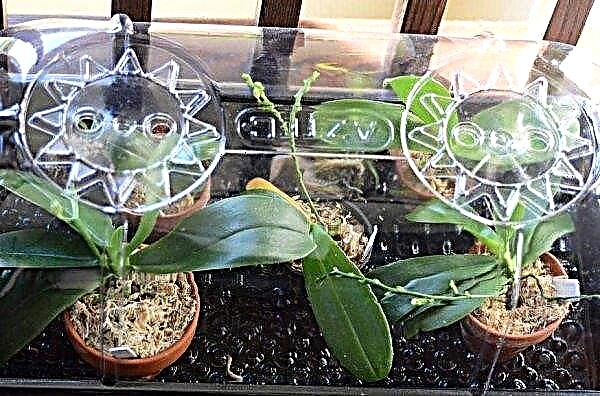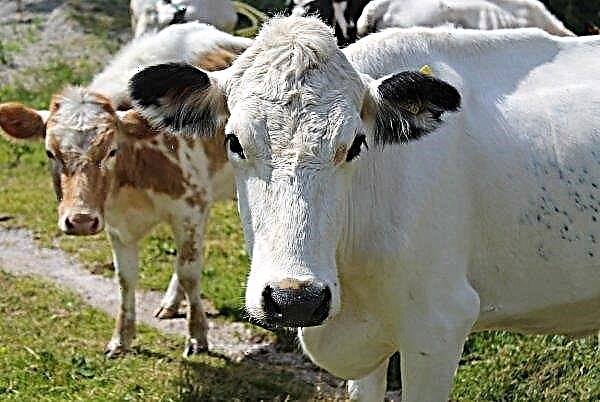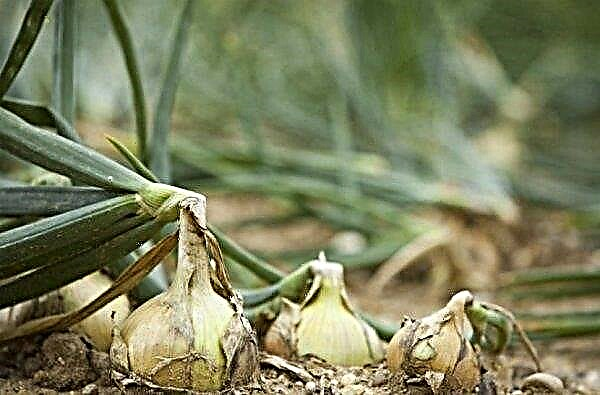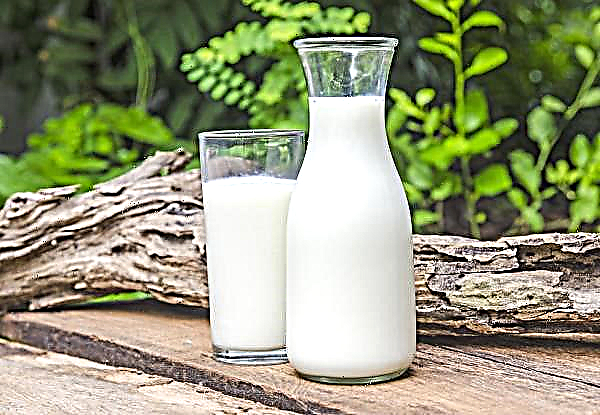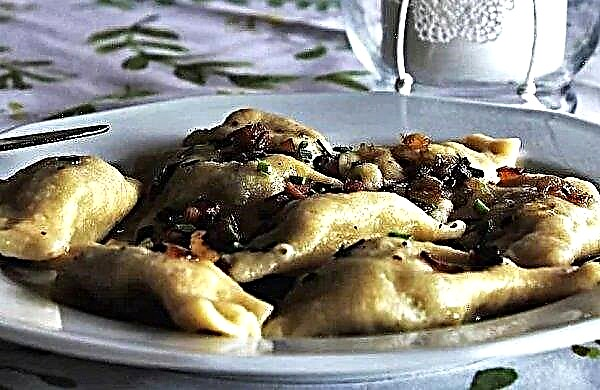The veranda is a great place to relax, the decorative and functional qualities of which largely depend on the exterior. You can do the installation of the casing with your own hands, however, first of all, you need to choose the right material. A detailed description of the best options from wood, metal and plastic, you will learn from this article.
How to sheathe a veranda outside
Annexes in the form of a veranda make houses more comfortable and cozy. Such a “room” in the open air will allow you to enjoy the aroma of flowers from the garden or the opportunity to drink a cup of coffee during a shower. Closed options for the veranda can easily be converted into a summer room, where the whole family will gather at the table. The first step for converting the terrace into a full-fledged annex is to select the materials that the walls will be sheathed in the future.
Did you know? Polycarbonate was invented in the middle of the last century. At that time, it was used not in construction, but in the defense and space industries as a material for components of military equipment and satellites.
Wood
Using wood to decorate the veranda gives the building an unusual appearance. This is due to the unique texture of each element of the material. In addition, wood is widely used in construction due to its strength and durability.
Such upholstery can be made of:
- lining;
- block house;
- imitation of timber;
- edged boards.
The first finishing building material is a rectangular panel. Due to their universal shape and easy handling, it is the lining that is easiest to use for wall decoration so that they turn out to be completely smooth. In addition, these panels have pre-made grooves, which facilitates their connection with each other. To give an unusual style to the veranda, the lining can be used in combination with plastic or forged elements. The ease of installation of the block house is determined by the presence of grooves and fixtures of structural elements.
The main advantage of this building material is to obtain a non-standard surface that looks like a real log cabin. The block house can be painted in various colors, which will create a unique design of the veranda. Imitation of the beam also has the form of a panel, the dimensions of which vary, reaching 9 m. Thanks to this, it is easy to realize a continuous wall covering without seams. The most important characteristics of this material are resistance to temperature extremes and moisture, which is important for cladding outside the building. Edged boards - a typical building material for laying flooring. Due to the thickness of this wood billet, the finish will last a long time and will be able to retain heat in the cold seasons. It is better to mount the boards vertically so that condensate, rainwater and other precipitation do not remain on the surface of the walls for a long time. A significant drawback of this finishing material is that the components do not have prefabricated fixtures, which is why it is better to install using self-tapping screws.
Edged boards - a typical building material for laying flooring. Due to the thickness of this wood billet, the finish will last a long time and will be able to retain heat in the cold seasons. It is better to mount the boards vertically so that condensate, rainwater and other precipitation do not remain on the surface of the walls for a long time. A significant drawback of this finishing material is that the components do not have prefabricated fixtures, which is why it is better to install using self-tapping screws.
They are stronger than nails, less prone to deformation and rust when the seasons change, when the boards swell and are constantly in moisture. When using all wood building materials for external cladding, after installation it is important to apply a layer of protective solutions or varnish. This will help the finish last longer, be more resistant to various weather conditions and avoid mechanical damage.
Siding
Compared with other building materials for cladding, siding has many advantages.
- Among them:
- wide selection of textures and colors;
- resistance to mold;
- visual alignment of deformed sections of the wall;
- ease of installation.
Wooden siding differs from traditional wooden building materials only in a wide selection according to criteria regarding appearance. Otherwise, these are almost the same panels as a block house: they are distinguished only by the way of fastening. If the siding is made of metal, it is still important to attribute high fire resistance and resistance to rot to the advantages. Also, this finishing material is not susceptible to corrosion and weathering, which makes it reliable and suitable for use for decades. To install the siding on the veranda, first design a drawing. It should assume the presence of a frame, the base of which consists of evenly distributed racks, united by strapping at the bottom, top and in the middle. A window should be located between the last two beams, the rest of the space will be covered with a casing. Siding panels are fastened with one edge to the profile, and the other to the previous bar, which even a person far from construction can do with his own hands.
To install the siding on the veranda, first design a drawing. It should assume the presence of a frame, the base of which consists of evenly distributed racks, united by strapping at the bottom, top and in the middle. A window should be located between the last two beams, the rest of the space will be covered with a casing. Siding panels are fastened with one edge to the profile, and the other to the previous bar, which even a person far from construction can do with his own hands.
Plastic and polycarbonate
The combination of plastic and polycarbonate in the decoration of the veranda makes the annex aesthetically beautiful and safe.
- Unlike metal and wood, such materials have the following advantages:
- reflection of ultraviolet radiation, which does not allow it to penetrate into the room;
- lack of fragments when receiving glazing damage;
- low thermal conductivity.
For the veranda, the last point may be decisive. If you want to use this room not only in summer, but also in winter - the retention of heat inside is a priority goal in the construction of the building. During the cold season, the inside of the veranda will be noticeably warmer than when using metal cladding. Wooden products made from robust and thick components also retain temperature, but such materials are not refractory. Durable plastic and polycarbonate, from the point of view of construction, can be easily processed even with simple carpentry tools. These building materials are easy to drill, making installation on the frame easier. Plastic sheathing can be easily installed on the structure using a drill and self-tapping screws. Using monolithic polycarbonate, it will turn out to build a completely transparent veranda, including the roof.
Durable plastic and polycarbonate, from the point of view of construction, can be easily processed even with simple carpentry tools. These building materials are easy to drill, making installation on the frame easier. Plastic sheathing can be easily installed on the structure using a drill and self-tapping screws. Using monolithic polycarbonate, it will turn out to build a completely transparent veranda, including the roof.
This will allow you to further isolate the room from the effects of the external environment, since a warm air cushion will accumulate under the ceiling. The only drawback is that it is physically difficult to attach a room with transparent polycarbonate walls because of the mass of the material: a 1 m² monolith with a thickness of 1 cm weighs more than 12 kg. It is important to consider this factor even at the stage of designing the veranda, so that the panels rest on the foundation trim.
Video: lining the porch with polycarbonate
Facing brick
The use of stone decoration materials will not allow cheaply lining the veranda. Cladding brick is one of the most expensive options for wall decoration, but this building material has many advantages.
- These include:
- reliability;
- protection of the frame and structure as a whole;
- resistance to mechanical damage;
- resistance to ultraviolet radiation.
Although the use of dense building materials does not have the best effect on thermal insulation, the use of hollow bricks in combination with insulation allows you to positively affect energy conservation. This allows us to consider the veranda as a heated room in the winter, and in the summer season as a cool zone. This method of plating has features. The main one is that the brickwork has a low bearing capacity.
Important! Masonry cladding is necessary only with a pre-formed foundation. Ordinary soil may not be able to withstand the weight load, and the structure is deformed.
Because of this, the finish is literally tied to the frame and the main walls. For this during masonry use flexible connections, metalwork or mesh. In the case of the veranda, it is enough to cover the skin with a thickness of half a brick. It is better to strengthen the structure with a flexible connection, which is a rod, one end of which is fixed in the mounting seam, and the second - directly in the finish. Simultaneously with the lining, a layer of insulation can be formed.
Decorative plaster
This material is presented in the form of a special mixture, which, after complete drying, forms a wall covering. To achieve the greatest decorative effect, it is worth using textured or colored plaster. With its help, you can apply unusual patterns to the walls or give the effect of marbling.
Important! Silk decorative plaster is not suitable for outdoor use. This is due to the fact that the material is easily exposed to moisture and can quickly lose its aesthetic properties.
Among all types of decorative plaster, the most popular ones should be noted, among which:
- stone;
- color;
- Venetian
- silk.
The first of them imitates the texture of natural stone, which, from the point of view of design, looks most beautiful with external decoration. Venetian allows you to give the wall a look of marble, which is more consistent with the interior. Silk plaster requires real craftsmanship from the builder, because using this mixture it will be possible to create unique patterns on the walls in a variety of colors, which is similar to “liquid wallpaper”. For exterior cladding, it is better to use imitation stone. The appearance of the veranda with such a finish will be most attractive. Other types of finishing mixture are more suitable for interior upholstery. However, along with the aesthetic benefits of decorative plaster, there are functional disadvantages.
For exterior cladding, it is better to use imitation stone. The appearance of the veranda with such a finish will be most attractive. Other types of finishing mixture are more suitable for interior upholstery. However, along with the aesthetic benefits of decorative plaster, there are functional disadvantages.
- These include:
- low resistance to mechanical damage;
- low thermal insulation;
- high degree of exposure to weather conditions.
If you plan to use the terrace only during the warmer months, this finish is suitable. However, for using the premises in cold seasons, it is better to choose a different type of casing. Finishing walls with this material with your own hands is quite simple: you just need to be able to use a spatula well.
By experimenting with different brush strokes and the amount of plaster applied, a unique visual style can be achieved. Real craftsmen with the help of this finishing mixture can create whole pictures on the walls, which in enclosed spaces have high strength and reliability.
Exterior Rules for the Veranda and Terrace
Since the veranda is primarily a summer room, you need to be prepared for the fact that in winter a large amount of moisture will accumulate. Therefore, for cladding it is better to use such materials that can hold not only temperature, but also water from the environment. If a tree is used, do not forget to cover it with protective layers and an antiseptic - this will also help to avoid mold.
In the case when it is supposed to use heavier materials, such as brick or plastic in combination with metal, think about creating a foundation even at the stage of designing a terrace. To design in a single style, take care of the appearance of the entire yard and cottage: for example, the color palette of the veranda should match them. If you used wood for decoration, you can lay out tracks from decorative boards on a suburban area.
Did you know? Cladding brick is better to buy from one batch. This is due to the fact that even materials produced at the same enterprise, but at different times, may have a different color shade.
Thus, when covering the veranda, you must choose between the concepts of "inexpensive" and "reliable." The terrace can serve for many purposes and in different seasons, because there is no universal finishing material to carry out the decoration. For the most decorative, it is worth using facing brick or plaster. To better maintain the high temperature in the room, a hollow stone with insulation and wood are suitable. To obtain a unique and modern style together with maintaining heat, the best, but also expensive option is polycarbonate with plastic elements. The most reliable finish on weather resistance and durability is made from siding, with which, in addition, just sheathe the building. For unheated outbuildings, it is enough to use a block house: it is reliable, inexpensive, easy to install and does not require special care.
To obtain a unique and modern style together with maintaining heat, the best, but also expensive option is polycarbonate with plastic elements. The most reliable finish on weather resistance and durability is made from siding, with which, in addition, just sheathe the building. For unheated outbuildings, it is enough to use a block house: it is reliable, inexpensive, easy to install and does not require special care.


